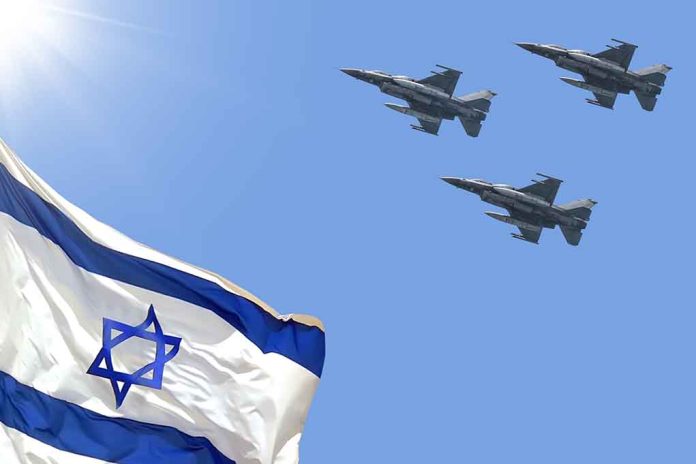
Israeli intelligence gains crucial insights from interrogating Hezbollah operative Wadah Kamel Younis, revealing chaos within the militant group following the alleged death of its leader Hassan Nasrallah.
At a Glance
- Hassan Nasrallah, Hezbollah’s leader, reportedly killed in an Israeli airstrike in Beirut
- Interrogation of Hezbollah operative reveals internal disarray and fleeing of posts
- Iran declares five days of mourning, warning Israel against further attacks
- Hezbollah’s acting leader vows to continue fighting despite leadership losses
- Concerns rise about potential increase in international terrorism by Hezbollah
Hezbollah in Disarray: The Aftermath of Nasrallah’s Reported Death
In a significant turn of events, Israeli intelligence has gained valuable information from the interrogation of Hezbollah operative Wadah Kamel Younis. The interrogation, presented in an IDF video, paints a picture of fear and confusion within Hezbollah’s ranks following the alleged death of their leader, Hassan Nasrallah, in an Israeli airstrike in Beirut.
The aftermath of Nasrallah’s reported death has sent shockwaves through the organization, with members reportedly fleeing their posts and disrupting internal command structures. This chaos within Hezbollah not only signifies a major blow to the militant group but also presents a strategic advantage for Israeli intelligence and military operations.
Iran’s Response and International Implications
The reported death of Nasrallah has far-reaching implications beyond Lebanon’s borders. Iran, Hezbollah’s primary backer, has declared five days of mourning and issued stern warnings to Israel against further attacks. This development complicates efforts to restore the 2015 nuclear deal and puts Tehran in a difficult position.
The UK’s Guardian newspaper reported that “Iran’s supreme leader, Ayatollah Ali Khamenei, called on Muslims to stand by the people of Lebanon and the proud Hezbollah with whatever means they have and assist them in confronting the wicked regime of Israel.”
The situation has also caught the attention of the international community, with the U.S. and its allies calling for a cease-fire to prevent further escalation. However, Israel shows little interest in halting its military operations, viewing this as an opportunity to weaken Hezbollah’s capabilities significantly.
Hezbollah’s Resilience and Future Threats
Despite the loss of its leader and several top commanders, Hezbollah’s acting leader, Naim Kassem, has vowed to continue the fight against Israel. This defiance raises concerns about potential retaliation and the group’s future actions.
“Israel was not able to affect our (military) capabilities,” Kassem said in a televised statement, the first time any senior Hezbollah figure has been seen since Nasrallah was killed. “There are deputy commanders, and there are replacements in case a commander is wounded in any post.”
Experts warn that Hezbollah might resort to increased international terrorism in response to these setbacks. This potential shift in tactics has put countries like Canada on high alert, especially concerning threats to Jewish communities and potential fundraising activities within their borders.
Israel’s Continued Offensive and Regional Impact
Israel’s military has shown no signs of slowing down its offensive against Hezbollah. With additional battalions mobilized for a potential ground invasion, the conflict has already displaced tens of thousands of Israelis and over 200,000 Lebanese civilians. The humanitarian toll continues to rise, with over 1,000 people killed in Israeli strikes in Lebanon in less than two weeks.
As the situation unfolds, the international community watches closely, hoping for a resolution that can bring stability to the region. However, with both sides seemingly entrenched in their positions, the path to peace remains uncertain, and the potential for further escalation looms large.
Sources:
- https://www.theguardian.com/world/2024/sep/28/hassan-nasrallah-hezbollah-iran-lebanon-israel-us-analysis
- https://apnews.com/article/lebanon-israel-hezbollah-airstrikes-28-september-2024-c4751957433ff944c4eb06027885a973
- https://www.pbs.org/newshour/world/hezbollahs-acting-leader-vows-to-fight-on-after-former-head-nasrallahs-death
- https://globalnews.ca/news/10784628/hezbollah-leaders-death-what-does-it-mean-for-canada/
- https://indianexpress.com/article/world/hezbollah-possible-leaders-after-hassan-nasrallah-death-9593898/
- https://www.wsj.com/world/middle-east/israel-targeted-hassan-nasrallah-the-fierce-islamist-behind-hezbollahs-rise-3acf635b
- https://www.npr.org/2024/09/29/g-s1-25348/israel-hezbollah-lebanon-hassan-nasrallah-timeline
- https://www.rferl.org/a/lebanon-israel-nasrallah-hezbollah-killed/33138385.html
- https://www.timesofisrael.com/irans-leadership-said-deeply-shaken-divided-over-response-to-nasrallahs-killing/
- https://www.washingtonpost.com/opinions/2024/09/28/hezbollah-hasan-nasrallah-death-israel-strike-lebanon/










